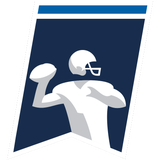- Jayden Daniels put together a historic rookie season: Daniels earned the highest single-season PFF grade by a rookie quarterback in the past decade, both as a passer and a runner.
- Jordan Mason shines in his opportunities: Mason has consistently delivered explosive plays throughout his three-year career, whether serving as the 49ers’ primary starter or making the most of limited touches in a rotational role.

The start of the fantasy football season is just days away. And while some drafts are already in the books, many are still on the horizon, so it’s not too late to make some bold predictions.
These aren’t the most likely outcomes, but they’re far more plausible than you might think.
Last year’s article correctly predicted that Jayden Daniels would average over 21 PPR points per game and that Zamir White would be a fantasy bench staple by midseason. A.J. Brown did finish just five spots ahead of DeVonta Smith in points per game, and Cole Kmet landed closer to TE30 than TE12. I did swing and miss on Brandin Cooks, though injuries played a big part in that.
Here are five bold predictions for 2025.
1. Jayden Daniels leads all quarterbacks in fantasy points
Daniels finished fifth among quarterbacks in both total fantasy points and points per game as a rookie—mainly driven by his elite rushing volume. His per-game average is slightly misleading, though. He attempted just two passes before exiting early with an injury in one game, and played less than a half in Week 18 with Washington’s playoff spot already secured. Excluding those two outings, Daniels averaged an impressive 23.7 fantasy points per game.
Daniels finished second among quarterbacks in both rushing attempts (148) and rushing yards (891), trailing only Jalen Hurts and Lamar Jackson, respectively. What truly set him apart was his scrambling ability—he led all quarterbacks with 4.4 scrambles and 35 scramble yards per game.
While his passing volume wasn’t high, he graded very well as a passer. His 83.0 passing grade was the best by a rookie quarterback in the last decade (as was his 88.2 rushing grade). He excelled when throwing outside the pocket and under pressure, showcasing rare poise and playmaking ability. There’s still room for growth, particularly against man coverage and on routine dropbacks from a clean pocket.



Daniels thrived in Kliff Kingsbury’s offense last season, and with Kingsbury returning as offensive coordinator, that continuity should benefit his Year 2 development. Kingsbury’s offenses have historically been balanced, with a high pace of play and frequent designed quarterback runs, traits that suited Daniels well in 2024.
The biggest departure from Kingsbury’s past offenses was Daniels’ deep passing volume. The rookie’s deep target rate lagged behind that of Kyler Murray during Kingsbury’s tenure in Arizona, when Murray frequently ranked among the league leaders in that category. There’s potential for more vertical shots in 2025, which could unlock another layer of Daniels’ game.
One clear area for improvement: reducing sacks. Daniels took 47 last season, the sixth-most among quarterbacks. While mobile quarterbacks often take more sacks, players like Josh Allen and Lamar Jackson have shown it’s possible to improve in that area over time. If Daniels takes a similar step forward, his fantasy ceiling only rises.



Washington knows it has a rising star in Jayden Daniels, and the front office made clear moves to support him in Year 2.
The Commanders traded for Deebo Samuel to serve as their new No. 2 wide receiver, providing a dynamic short-area weapon to pair with Terry McLaurin. While Washington was above average in yards per attempt on deep, intermediate and behind-the-line throws last season, they lagged on short passes. That’s where Samuel thrives. Over the past five seasons, he’s averaged 11.4 yards per reception on short passes, the most among 133 qualifying receivers.
They also made a major upgrade at left tackle by acquiring Laremy Tunsil. Daniels performed surprisingly well under pressure as a rookie, but those splits tend to widen over larger samples. Tunsil’s presence should improve Daniels’ protection, while the quarterback must still work to reduce his high sack total.
Outside of Tunsil, this offense may lack other All-Pro candidates—but Daniels still has more high-end support than most top fantasy quarterbacks, including Josh Allen and Lamar Jackson. That foundation only bolsters his already elite upside.


Daniels was already one of fantasy football’s top quarterbacks last season—and there’s reason to believe he could be even better in Year 2. With Washington upgrading his supporting cast and offensive line, and Daniels entering another season under Kliff Kingsbury, his path to improvement is clear. Meanwhile, top-tier quarterbacks like Josh Allen and Lamar Jackson could see slight regression. The only question: can Daniels take a big enough leap — or will the current elites take just enough of a step back — for him to claim the No. 1 spot in fantasy football?

2. Jordan Mason scores more fantasy points than Aaron Jones.
Mason was an undrafted rookie who signed with the San Francisco 49ers in 2022. By midseason, the 49ers completely changed their backfield, trading for Christian McCaffrey and elevating Mason to the primary backup. Mason did an excellent job on his limited snaps, earning a 90.6 grade and averaging 6.0 yards per carry. In 2023, Mason fell to third on the depth chart with Mitchell’s return. Mitchell missed some time, allowing Mason to be a primary backup, and he played at a high level, like in 2022. There was talk heading into 2024 that Mason would replace Mitchell as the primary backup to McCaffrey. Mitchell ended up suffering a season-ending injury, allowing Mason to be the primary backup. McCaffrey was dealing with an Achilles sprain to start the season, elevating Mason to the top back on the depth chart.
Mason was a top-six fantasy running back over the first five weeks of the season. He fumbled three times over the season, which lowered his PFF rushing grade, and there was some expected regression in his rushing efficiency over a larger sample size, but for the most part, he continues his electric play. He broke long runs at an elite rate, ran for at least 70 rushing yards in six of his first seven games and averaged at least 4.1 yards per carry each week. He didn’t develop much as a receiver, finishing with one or two receptions each week.
Unfortunately, Mason suffered a shoulder injury in Week 6 and re-injured it in Week 7. McCaffrey was able to return for a four-week stretch, bringing Mason to a backup role. It’s worth noting that any of his per-game metrics from 2024 include him being a backup for nearly half of his games. McCaffrey suffered a season-ending injury in Week 13, leading Mason to run 13 times for 78 yards, but then Mason was dealt a season-ending high-ankle sprain.


Mason was traded to the Minnesota Vikings this offseason, offering a chance to escape Christian McCaffrey’s shadow and earn meaningful snaps. He joins a backfield led by Aaron Jones Sr., who has spent much of his career in a two-back committee. Now 30, Jones has battled a slew of injuries—hamstring, MCL, hip, rib, and quad—over the past two seasons.
Mason has operated primarily as an early-down back in his career, while Jones brings more versatility, including 408 receiving yards last year—his highest mark since 2019. While Jones still flashes in the passing game, his rushing efficiency has declined in recent years, falling closer to league average.
A likely early-down and goal-line role for Mason would give him fantasy upside, especially in touchdown-heavy formats. If Jones stays healthy, Mason should still handle a solid share of the rushing workload. If Jones misses time, Mason could slide into a featured role similar to his stint as San Francisco’s starter—minus third downs, which would likely go to C.J. Ham in pass protection. Ty Chandler profiles as Mason’s backup, but the Vikings would likely ride Mason as far as he can go in the event of an injury.

It remains to be determined exactly how snaps will be distributed between Mason and Aaron Jones Sr. Still, there is a chance Mason is the better fantasy back if both are healthy, and he is likely to be a fantasy starter if injuries continue to disrupt Jones’ career.
3. The Day 3 rookie wide receiver with the most fantasy production finishes better than any Day 2 rookie wide receiver.
Ten wide receivers were selected on Day 2 of the 2025 NFL Draft—and most are off to a slow start.
Jayden Higgins (Texans) and Luther Burden III (Bears) were among the earliest selected and initially looked poised for immediate starting roles. But both have yet to crack the starting lineup, with Xavier Hutchinson and Olamide Zaccheaus consistently working ahead of them in preseason action. While there’s still optimism they’ll climb the depth chart, both currently appear locked into WR3 roles to open the season.
Tre’ Harris (Chargers) and Jack Bech (Raiders) were the final picks in Round 2. Neither got playing time with their teams’ starters during the preseason. The Chargers added Keenan Allen, and the Raiders acquired Amari Cooper, making it unlikely either rookie will see much early action. Fantasy players should view both as rotational pieces—not typical redraft targets this year.
In the third round, Isaac TeSlaa stands out. With the Lions trading Tim Patrick, he now has one of the clearer paths to playing time among Day-2 receivers. However, he’ll be competing with Amon-Ra St. Brown, Jameson Williams, Sam LaPorta, Jahmyr Gibbs, and David Montgomery for targets.
Other third-rounders — Kyle Williams (Patriots), Jaylin Noel (Texans) and Pat Bryant (Broncos) — are projected to serve in rotational roles behind established veterans. The playing time for Savion Williams (Packers) and Tai Felton (Vikings) remains unclear.
On the upside, Dont’e Thornton (Raiders) played every snap with the starters in the preseason. While Las Vegas rarely used 12 personnel with the first unit in preseason, Thornton is poised to see significant playing time in that package. He offers a different look compared to the other Raider receivers.
Tory Horton (Seahawks) has already ascended to the No. 3 wide receiver spot in Seattle. With a run-heavy offense likely to feature 12 and 21 personnel, his impact may be limited—but he’s still ahead of every other Day‑2 rookie on the depth chart.
Jalen Royals (Chiefs) could carve out a role with Rashee Rice suspended. Epic Ayomanor (Titans) and Arian Smith (Jets) are still developing, but both could be starting sooner rather than later. Jaylin Lane (Commanders) sits fourth on the depth chart and would be in line for a significant role if injuries strike.
From a fantasy standpoint, Higgins still has the highest upside, but Thornton may offer the most consistent production. If all players hit their median projections, he’s likely to finish with the most points among the group.

4. Rashee Rice finishes in the top five in fantasy points for wide receivers from Weeks 7-17.
Rashee Rice went 55th overall in the 2023 NFL Draft. He spent much of his rookie season in a crowded wide receiver room, with eight players logging at least 120 snaps and nobody topping 700. He emerged early, scoring a touchdown in Week 1 on just 20 snaps and then catching five passes for 59 yards in Week 3 as his role expanded. Starting Week 6, he delivered at least 8.0 PPR points every game. He played over 60% of offense snaps in Week 8 and didn’t clear 70% until Week 14, despite months of strong play.
From there, the Chiefs treated him like a full‑time wideout. Rice logged 88.9% of offensive snaps in the conference championship game and 84.8% in the Super Bowl. Expectations were high heading into Year 2 until he was involved in a high‑speed crash. Many expected a long suspension, hurting his fantasy ADP. When no suspension materialized, his value rebounded, making him a steal in many leagues.
Rice caught fire in the first three games of 2024: a 74% snap share, 103 receiving yards in Week 1, 75 and a touchdown in Week 2 and 110 yards with a touchdown on 12 catches in Week 3. His 64.9 PPR points were second among wideouts. He suffered a torn LCL on his fourth play of Week 4, cutting short a breakout stretch.
Across the 11 full games he’s played since earning 70% of his team’s snaps, Rice has averaged 17.9 PPR points per game — a reliable top‑10 fantasy finish pace. His receiving yards after catch per game (42.05) lead all wide receivers despite his limited snaps. His 88.9 receiving grade ranks 12th, and his 2.54 yards per route run ranks eighth. At full health and locked in with his quarterback and coach, Rice would be viewed as a top‑12 fantasy receiver.
Rice will miss the first six games due to suspension, but he appears fully healthy based on preseason form. That absence cuts into value, but fantasy players should compare him to mid‑round receivers rather than write him off. A savvy owner will draft Rice, absorb six weeks of down performance, and reap massive rewards the rest of the season, including fantasy playoffs.

Despite the suspension, Rice’s situation in Kansas City gives reason for serious optimism. Andy Reid is one of the most pass-heavy coaches in the league, dialing up high-volume passing games. The low receiver target share is mainly because Travis Kelce dominates the menu.
On top of that, Patrick Mahomes is one of the most accurate quarterbacks in football. His low deep-target rate lines up with how Rice has been used so far, and that fits Rice’s skill set.
Historically, Reid and Mahomes have produced elite fantasy WR seasons, as Tyreek Hill and Travis Kelce both topped 290 PPR points in multiple years. While it’s premature to compare Rice (or Worthy) to future Hall of Famers, that level of upside is exactly what this KC situation can offer.


Rice was a top-two fantasy wide receiver last season prior to injury. His suspension will slow him down, but his upside is very high given his talent when he was healthy.
5. Brock Bowers finishes outside of the top two fantasy tight ends.
Brock Bowers joined the Las Vegas Raiders and immediately became the league’s top fantasy tight end. He led all tight ends in receptions and receiving yards as a rookie, resulting in the most fantasy points. BothTrey McBride andGeorge Kittle missed games and finished slightly ahead of Bowers in fantasy points per game. His 88.4 receiving grade also finished third among tight ends, behind Kittle and McBride.
He became more of a part of the offense as the season progressed. He played less than 70% of the Raiders’ offensive snaps in the first three weeks. Once Week 8 hit, he played a minimum of 85% of their offensive snaps every week for the rest of the season. He had three games of double-digit targets over the second half of the season, and both of his 100-yard performances occurred during the season’s second half.
Bowers is relatively small for a tight end at 230 pounds.Dalton Kincaid,Chigoziem Okonkwo and Juwan Johnson are also tight ends under 240 pounds, and all of them have had issues with playing time during their career. The fact that Bowers played so much was huge for his fantasy production.

Bowers returns to a tight end room with Michael Mayer. There were some trade rumors around Mayer this offseason, but nothing has materialized to this point. The Raiders also added Ian Thomas from the Carolina Panthers, and one of them will be the run-blocking tight end in two tight-end sets. Both Mayer and Thomas have graded better than Bowers as run blockers over the last two seasons, which is unsurprising given Bowers’ size.
Mayer played 20 snaps with the Raiders starters during the preseason compared to 11 by Bowers. They primarily played in 11 personnel, outside of sharing the field for two goal-line snaps. The two split snaps on first downs, with Mayer taking all of the second downs, and Bowers taking most of the third downs. While we can expect the Raiders to use a lot more 12 personnel in the regular season, this usage isstill concerning.
If we assume a 60% rate of early down 11 personnel snaps for Browers, that would be roughly 19 fewer routes for him this season, and at his 0.44 fantasy points per route, that would be a decrease in 0.49 fantasy points per game. Last season, 0.3 points per game was the difference between TE1 and TE3. In this case, that’s enough to move Bowers below McBride and Kittle in my rankings, but still far ahead of all other tight ends. There has been little reason to change opinions on McBride, and the longer the 49ers’ starting wide receivers are out with no update, the better Kittle’s potential looks.
This change is amplified in my rankings because my rankings also take into account where you should be picking players. I no longer believe you should be considering Bowers in the second round when you can pick McBride or Kittle in the third round. I still think it’s important to land a top-three tight end, given the landscape at the position relative to other positions. This has moved McBride and Kittle up to ensure that you land a top tight end. This is a relatively small change in projected performance, but such changes often lead to significant shifts in the rankings, as the gap between closely ranked players is typically small.
You can find a more detailed breakdown on why you should avoid Bowers in the second round here.

This news was originally published on this post .







Be the first to leave a comment